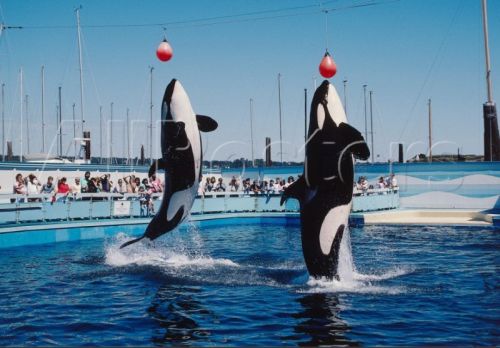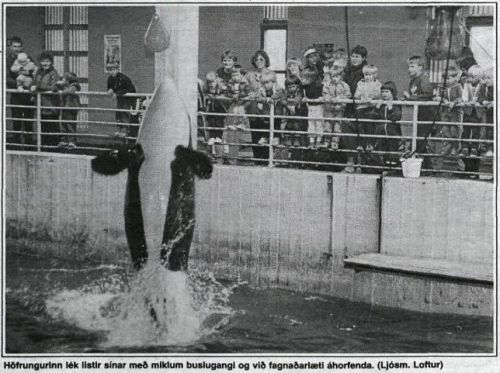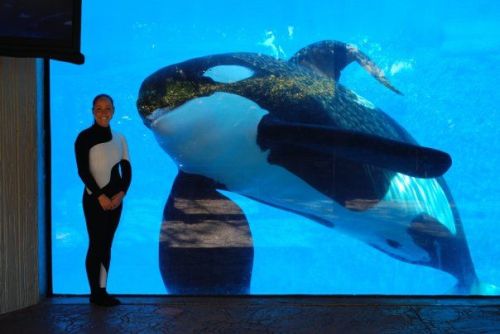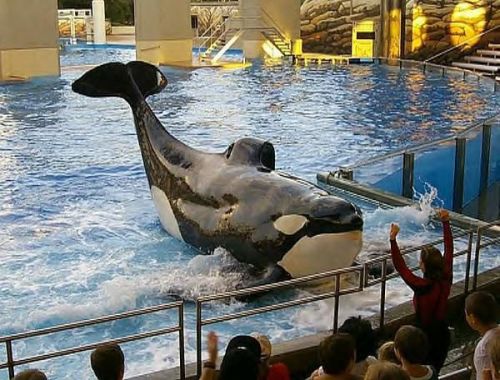#tilikum
Here it is - uploaded before chapter 7, because I have to update the lifespan data (as it is outdated by many years).
Do read the description before commenting…
Gender:Male
Pod:N/A
Place of Capture: Togi, Iceland
Date of Capture: November 9, 1983
Age at Capture: Approx. 2 years
On November 9, 1983, three young whales were captured off the coast of Iceland and immediately transferred to the Hafnarfjordur Aquarium. Here, they were trained and put up for sale.
The following year, a 3 year old male was purchased by Sealand of the Pacific in Victoria, Canada. He was later known as Tilikum, a Chinook Jargon word meaning “friends, relations, tribe, nation, common people”.
When he arrived at Sealand, he met the resident females, Haida II and Nootka IV who were more dominant and displaced Tilikum on a regular basis.
In 1982, a year before Tilikum arrived, Sealand housed a rescued female named Miracle who drowned after the nets were cut and she became entangled in them. This resulted in Sealand beginning to store the whales at night in the “module” - a roughly 20 x 30ft. metal pool - to prevent anymore whales from becoming entangled in the nets. According to former staff who appeared in the 2013 documentary Blackfish, when they arrived in the mornings, Tilikum would often be covered in rakes from the other whales.
The whales performed together for about 8 years until one incident caused Sealand to close down permanently.
On February 20, 1991, part-time trainer Keltie Byrne was carrying a cooler along the side of the pool before accidentally falling into the water. She attempted to climb out of the pool, but all three whales quickly swam over and pulled her away from the edge before proceeding to submerge her repeatedly until she was unconscious. Other trainers tried to distract the whales as well as pull Keltie out of the water, but were unsuccessful. Ultimately, Keltie drowned and emergency respondents were unable to retrieve her body for at least 2 hours.
At the time of the incident, both Haida II and Nootka IV were pregnant by Tilikum, though Haida II’s calf was the only one to survive, and was later named Kyuquot.
In 1992, SeaWorld stepped in and bought all four whales. Tilikum and Nootka IV were sent to the Orlando park while Haida II and Kyuquot were sent to the San Antonio park. It didn’t take long before Tilikum proved himself to be SeaWorld’s most successful breeding male ever, having sired 21 calves, though only 10 are alive today.
On July 7, 1999, Tilikum was involved in yet another incident, though this was not with a trainer, but with a park guest.
Daniel P. Dukes had visited the park the previous day, but managed to hide in the park until after closing. He then proceeded to climb into Tilikum’s tank and was found the next morning naked, covered in bruises, bite marks, and abrasions, and draped over the whale’s back. The coroner’s report concluded that Dukes’ cause of death was drowning, but goes on to list various injuries including a number of contusions, abrasions, and wounds sustained whilst he was still alive as well as postmortem, a mild subarachnoid hemorrhage of the cerebellum, and avulsion (forcible separation or detachment) of his genitals. Toxicology reports confirmed that Dukes was not intoxicated at all at the time of his death, though there are claims that he had a history of mental illness.
Tilikum had also been known to lunge towards the control trainer when he became frustrated. His profile also warned trainers of his previous incidents with Miss Byrne and Mr. Dukes. Despite trainers having to exercise caution around Tilikum, he was involved in yet another death in 2010.
On February 24, 2010, after an afternoon show resulted in several whales becoming aggressive with each other and one female sustaining an injury just above her eye near the end of the show, senior trainer Dawn Brancheau was set to perform a “Dine with Shamu” show with Tilikum.
After the show was over, Dawn continued over to a slide out area where she can be seen, in a video taken by a park guest, laying on her stomach for a ‘relationship session’ with the bull Orca. Almost immediately after lying down, Tilikum grabbed Dawn by her left arm, pulling her into the pool and beginning to violently thrash her body about in the water while at least a dozen park guests looked on in horror.
Other trainers attempted to distract Tilikum by throwing food at him and using nets but were unsuccessful. Eventually, they were able to direct him to the medical pool where he released Dawn’s body and was able to be calmed. SeaWorld went on to claim that Dawn was pulled in by her ponytail, and that Tilikum may have mistaken it for a toy or she may have touched her hair after handling fish, leaving the scent on her hair; though witnesses to Dawn’s death stated that Dawn was pulled in by her arm.
The autopsy report concluded that Dawn’s cause of death was due to drowning as well as traumatic injuries. Her injuries included complete avulsion of the scalp from the head as well as complete avulsion of her left arm. She suffered lacerations to her right ear, liver, and extremities, along with a fracture to the 7th cervical vertebra.
In Blackfish, former SeaWorld trainers noted that after Dawn had asked Tilikum for a ‘perimeter pec wave’, he did perform the behavior correctly, but missed the whistle bridge and Dawn responded with a 10 second neutral response and dismissed giving him a reward for his behavior before proceeding to ask him for a different behavior. They also noted that Tilikum could likely hear that Dawn was beginning to run out of fish, signaling that they were coming to the end of session, potentially causing him to be less focused or motivated near the end of the show.
On August 23, 2010, the Occupational Safety and Health Administration (OSHA), fined SeaWorld $75,000 for three safety violations. Most notably, one violation classified as a “willful” violation for “exposing employees to struck-by and drowning hazards when interacting with killer whales.”
SeaWorld issued a statement claiming that OSHA’s findings were “unfounded” and announced plans to contest the citation. OSHA said that trainers should not be allowed to swim with the remaining whales unless they are protected by a physical barrier or “through the use of decking systems, oxygen supply systems or other engineering or administrative controls that provide the same or a greater level of protection for the trainer.”
While SeaWorld attempted to contest the ban of waterworks, Tilikum was isolated and was not allowed to perform in shows until March 2011, and was often only seen performing in splash sessions with his grandson Trua - who was born in 2005 to the captive born female Takara. Tilikum was briefly removed from shows in December 2011 after becoming ill with Bronchitis, but recovered and resumed performances in the spring of 2012.
In April 2014, after a long court battle, a U.S. appeals court panel upheld the ruling by OSHA that SeaWorld violated its duties by exposing trainers to “recognized hazards” when working with the whales, and must limit whale-trainer contact during shows. This ban effectively removed trainers from the water and prohibits them from interacting with the whales without supervision and physical barriers in the form of removable metal bars. Though it sparked outrage among faithful SeaWorld supporters, so far, SeaWorld has chosen not to file an appeal with the United States Supreme Court.
In early March of 2016, SeaWorld announced that Tilikum was seemingly in failing health due to a bacterial infection in his lungs. Over the course of the year, updates on the bull Orcas health were scarce - though it seems that he did appear in some shows.
Unfortunately, on January 6, 2017, SeaWorld made the announcement that the 36-year old whale had died as a result of a bacterial lung infection.
x|x|x|x|x|x|x|x|x|x|x|x|x|x|x|x|x|x|x|x|x|x|x |x
Post link
10 Reasons Why Orca Whales Should NOT be at Seaworld (Or Any Marine Park)
- In the wild, orcas swim up to 100 miles a day. They are confined into a small tank in captivity.
- Their collapsed dorsal fins (pictured above) are a sign of an unhealthy whale. All male orcas in captivity have a collapsed dorsal fin. Less than 1% of orcas have this condition in the wild.
- Orcas do not live up to their nickname “killer whale”. There has not been one incident of an orca killing a human in the wild. However, in captivity, orcas have killed 3 humans and injured 151 reported injury incidences.
- On average, orcas live up to 50 years old in the wild. Some females have been reported to live 80-100 years old. Seaworld’s average orca life span is 13 years old.
- Family is important to orcas. In the wild, their pods include generations upon generations of their family. Marine parks do not keep their families together. In fact, babies are taken from their mothers. This is psychologically traumatizing to the whales.
- Whale fights are common in the tanks because they are not in their pods and they are, literally, mentally ill. In a tank, whales can’t flee from fights like they can in the wild. These whales get brutally injured and sometimes killed by other whales in the tank.
- Pods have their own languages. In a tank with other whales who have different languages. Imagine living with somebody who speaks a different language with you and you cannot use hand motions. Frustrating right?
- Not only are the tanks in marine parks WAY too small for this wild animal, in the wild, marine mammals live in a habitat full of MANY other marine plants and animals. In captivity, they live in a cement, chlorinated tank.
- Since 1961, 141 whales have been captured. 125 of these whales have died.
- The brain of an orca is 4 times larger than the human brain. It has been confirmed their intelligence matches to ours, if not more.
Just imagine living in cement room with a few other people who don’t speak your language. Imagine not knowing if you will ever see your family again. Imagine being forced to do performances for others and being fed one thing for the rest of your life. Imagine being confined in a cement room when there is a whole world out there to explore.
So, how can you help? It’s easy! boycott sea world. Without the revenue, they are forced to shut down their business. Also, education is important. Remind the public of what is going on.
Post link








